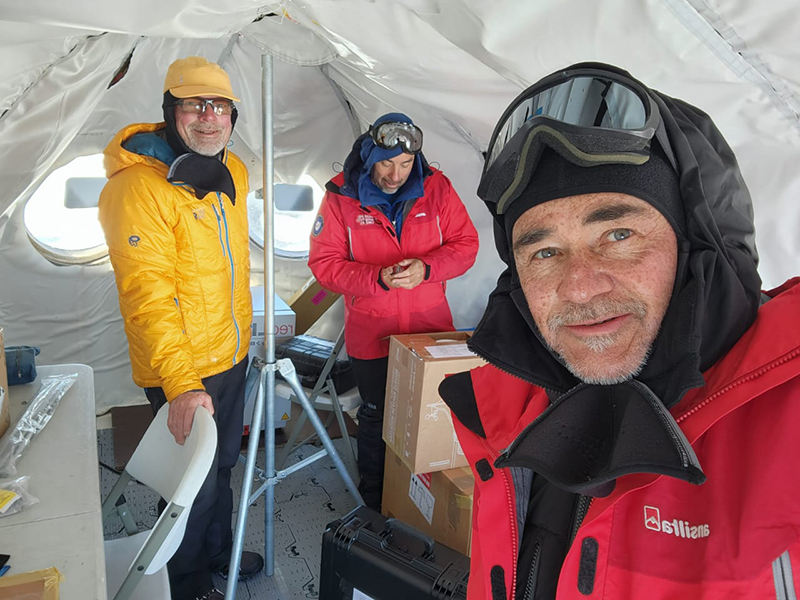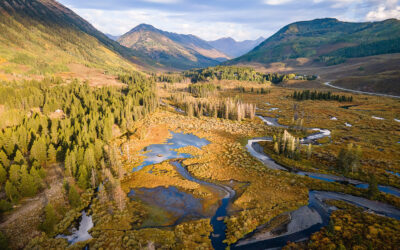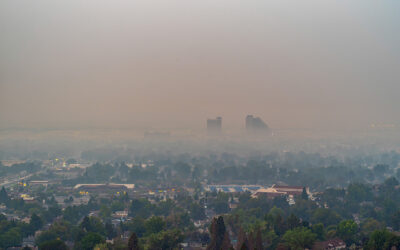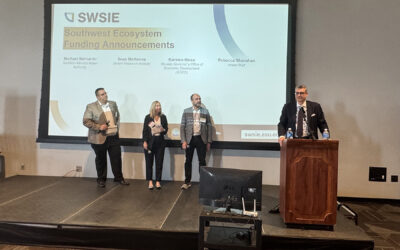Moosmuller joins researchers from Chile’s Universidad Tecnica Federico Santa Maria for the study
*The below text is translated from the original Spanish and shared with permission from Chile’s Universidad Tecnica Federico Santa Maria
Hans Moosmuller, Ph.D., joins two Chilean scientists from the Center for Environmental Technologies (CETAM) of the Universidad Tecnica Federico Santa Maria on an expedition to Antarctica’s Unión Glacier, located just a thousand kilometers from the South Pole. They will work under extreme conditions, with temperatures of – 40°C and high winds, to take the first measurements of gaseous pollutants such as ozone, Volatile Organic Compounds (VOCs), and aerosols.

Trying to understand the effects and anthropogenic responsibilities of pollution, a fundamental part of climate change, is one of the objectives of the trip to the white continent made by the director of CETAM, Dr. Francisco Cereceda, from the Federico Santa María Technical University, the glaciologist Dr. Gonzalo Barcaza (CETAM) and Dr. Hans Moosmüller of DRI.
During the period of the journey, the phenomenon called “polar day” or “midnight sun” will be present, which means that the sun does not set during the night. The researchers will also work under low temperatures that can reach more than -40 °C and extreme winds of more than 180 km/h.
The team will travel almost 3 thousand kilometers from Punta Arenas to the Joint Scientific Polar Station Glaciar Unión, in extreme Antarctica, to participate in the Antarctic Scientific Expedition number 60 (ECA-60).
According to Cereceda, who is also a professor at the USM Department of Chemistry, this trip is of vital importance, since “the measurements we will obtain at the Unión Glacier will help us generate a baseline in our research, due to the limited availability of human presence and contamination in the study area. This will be complemented by the measurements carried out in January 2023 in the eastern part of the peninsula and the future expedition in summer 2025 in the western area, where there is a greater presence of contamination of human origin.
In relation to the objectives of the expedition, Cerecada said that “being able to obtain information from these areas, all with different degrees of contamination and anthropogenic influence, will help us achieve our objective of understanding and decoupling the effects and responsibilities of climate change and how much we can attribute it to pollution of local origin.”
Unique measurements
Among the topics that draw attention to the journey, they highlight that “in the expedition, gaseous pollutants such as NOx, O3, SO2, H2S, CH4, Benzene, Volatile Organic Compounds (VOCs) and aerosols will be measured for the first time in this remote place, with different online monitoring equipment, which will allow the measurement of particle concentration (PM10, PM2.5 and PM1.0), the size distribution of atmospheric particles (between 0.26-34 um in 30 different channels), and the concentration of black carbon (BC) in air and snow. Radiative forcing will also be measured with a broad-spectrum spectrometer,” said Dr. Cereceda.
In addition, a physicochemical characterization of the snow will be carried out in situ, measuring various parameters such as granulometry, T°, density, pH, and electrical conductivity, among others, both at surface level and at depth.
Likewise, and thanks to Dr. Moosmüller’s equipment, “the optical properties of the snow and the atmospheric particles deposited on the snow and ice of the Unión Glacier will be measured, using a portable spectroradiometer, assisted by a penetrometer that allows measuring profiles of snow density at depth. Of course, this will always be accompanied by meteorological data and albedo measurements,” he said.
According to Dr. Cereceda, the idea is to install two monitoring stations, the first near the base and the other several kilometers in the opposite direction to the wind, in order to obtain information on the air quality in a pristine site.
Furthermore, Dr. Cereceda added that “recently the planet exceeded for the first time the 2°C increase threshold, a temperature that the entire scientific community identified as critical, while Antarctica has already exceeded 3°C increase in temperature in some parts of the Peninsula, being the most sensitive part of the planet to climate change. Therefore, Antarctica is the planet’s thermometer, and what happens in Antarctica is decisive for the future of humanity.”
Challenges
Glaciologist Dr. Gonzalo Barcaza said that “the Unión Glacier has an approximate area of 80 km2, an ice thickness of 1,500 m deep (900 m below sea level), and is located only 1,080 kilometers from the South Pole.”
It is possible to reach this base only by air, either by direct flight of 3 thousand kilometers from Punta Arenas or by stopping at the Frei Montalva base, one of the main scientific facilities in the country, located on the Antarctic Peninsula at 2 thousand kilometers.
Therefore, the challenges presented by this new journey are of several types: to travel to the measurement points, they must travel in Twin Otter airplanes, on snowmobiles, and by cross-country skis with the assistance of Chilean Army personnel for security reasons, and the team will camp in tents at the Unión Glacier Base.


